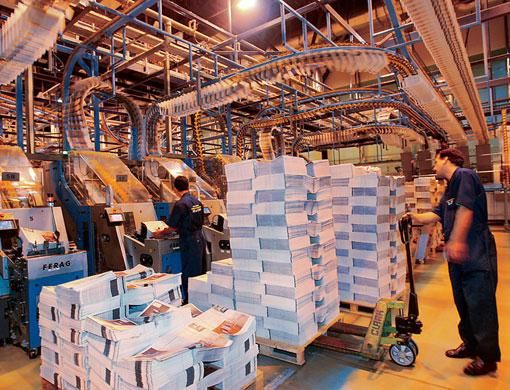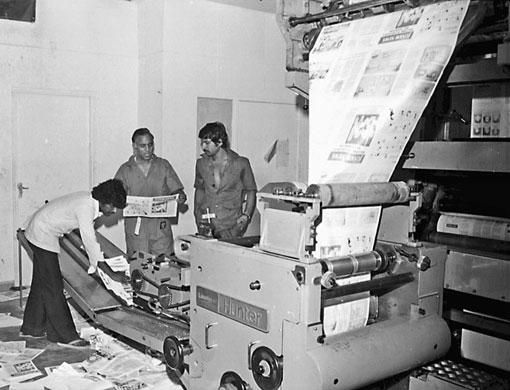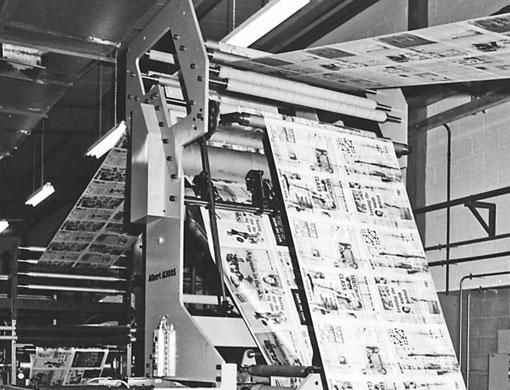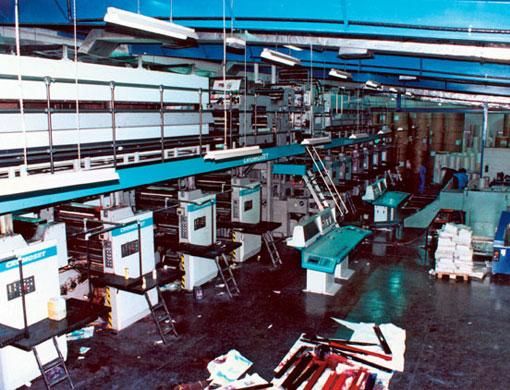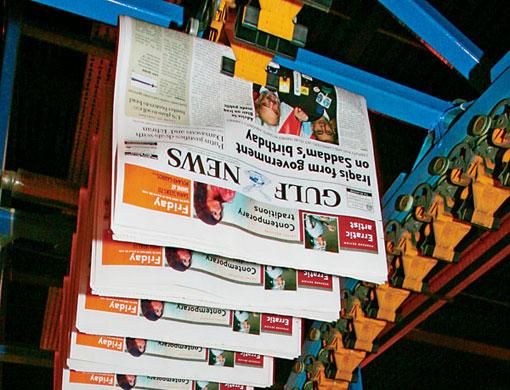A behind-the-scenes look at the technological advances the printing presses have undergone over the years to keep Gulf News ahead of its competitors
To step from the quiet buzz of the Gulf News newsroom into the aircraft hangar-like building that houses the printing presses for the newspaper is an enthralling experience. Going in from the second-level entrance, you encounter the two imposing printing presses, and the first thing that strikes you is the enormity of it all.
From here, you can see the stream of activity that goes into bringing you your daily paper. You are hit instantly by the infectious buzz that comes from the deadline-anxious atmosphere. The deafening sound of the ever-busy machines overwhelms all your other senses, while you try to make sense of it all.
Dare if you will to walk down the winding iron staircase to take a closer look at the action. You feel dwarfed by machinery - nuts, bolts, rollers, flashing buttons. Along the wall there are two-storey stacks of ink and lines of rolls of paper wrapped in casing at the ready, while frantic human activity goes on around them.
Forklifts come and go. Paper runs furiously through the machines. First black, then, cyan, magenta, and yellow. Menacing-looking grippers run on tracks, clasping onto the freshly printed paper. Every human movement is urgent. Every press of the button and glimpse at a monitor is packed with importance.
At the end of the production line you find the mail room, where humans outnumber machines. There are more than 26 people in blue overalls in here. It's hard to imagine that just 30 years ago it was a completely different story. Thirty years ago, a mere six people made up the entire production team.
When you consider the 63,000 tonnes of paper, 1,560 tonnes of ink and 8,760 hours a year that go into bringing you your daily copy of Gulf News, you begin to realise that printing the newspaper is no small feat. Every day, around 128,000 copies are printed by the modern Cromoman printing presses at the company's headquarters on Shaikh Zayed Road, and the entire process is monitored carefully and maintained by the production team.
Remarkable growth
When you also consider, however, that when Gulf News was initially published in 1978 at its old premises on Airport Road, only 6,000 copies were printed daily by the six people who made up the original production team, you really appreciate the newspaper's growth, as well as the advances in technology that have allowed it to happen.
But what is really remarkable is that this is only half the story. In a separate part of the building you will find the commercial printing section of Al Nisr Publishing. Here, publications such as Aquarius, Friday, Wheels and InsideOut are printed by the state-of-the-art MAN Polyman printing press. In addition to the Polyman are the two state-of-the-art five colour sheet-fed printing presses with automated digital colour density control. After the printing of the sections of each magazine they are then run through the highly automated binding processes.
Judicious investment
During its 30-year history, Al Nisr Publishing has never hesitated in investing in top-of-the-line machinery to print its publications, and as the newspaper has grown, so have the capabilities of the printing presses used.
When the newspaper was launched on September 30, 1978, a Hunter press was used, which could print 12 pages, single colour, in tabloid format.
This printer used Linotype technology, which meant that the operators had to manually assemble the lines of type by use of a keyboard. Each line was then cast as a single ‘slug' of molten metal (slug was the term used by the printing trade to describe a line of type).
One of the men who has seen all of the transitions of the printing presses is Pazhaniappan Kalathil-parambil (Pazhani), 52, a senior printer. Kalathilparambil, originally from Kerala, joined Gulf News in June 1980 as a helper. "Originally, my job entailed preparing the printing press and starting it up so it would be ready for production. Back then, everyone including editorial, printing and marketing worked together closely, like a family. Today, the company is so big that we don't see each other much anymore," he said.
In January 1979, the paper changed from tabloid to a broadsheet format, 16 pages in black and white. In 1982, colour advertisements were introduced, with the four pages that contained the ads being printed separately from the 12 black and white pages.
New premises for Gulf News were built during 1985, with the first issue of the newspaper printed and published there on January 10, 1986. Along with the new premises, the company invested in an Albert Frankenthal printing machine, which made Gulf News the first newspaper to have heat-set colour printing on glossy paper in the Middle East.
"We could now print 20 pages broadsheet, with four pages being printed in colour. This made the job a lot faster. The new machine also counted the number of papers that were being printed," explained Kalathilparambil. "This was the first printer used at Gulf News that utilised a dryer, which meant that following print, the paper would be dried by air. It would be chilled after. Back then we only had one dryer - today we have six," he said.
The Albert Frankenthal machine signalled the introduction of offset printing, which is the technology that is still in use today.
In 1993, Gulf News bought a Cromoset press, which was the first press allowing two heat-set webs in the same newspaper product. This was the first electronic printing press to be used by the company, and it had the ability to print 20 pages in black and white, and eight pages in colour.
From the humble beginnings of the manually operated Hunter machine, the Gulf News printing presses of today are beyond recognition. In 1999, it invested in two state-of-the-art MAN Roland Cromoman printers, which marked the shift to a fully computerised system.
One of the men who helps makes the newspaper production happen is Dean Du Toit, senior production manager. "Gulf News is the largest newspaper packet in the world and it's produced daily. Today, we can print 72 broadsheet pages full-colour, with 24 of these pages containing a glaze - we are the only company in the world that can do it. Whoever picks up a copy of Gulf News is amazed by the quality, the colour and the crispness of the product. We take a lot of care to preserve that, so the printing process is very carefully monitored throughout."
The current computer-to-plate (CTP) technology eliminates the need for the manual production of the printing plates. Today, the PDF file is output directly to the printing plate. PDF files of the newspaper, sports and business sections are made up in the newsroom and then sent to production for processing and finally printing and finishing. These files are processed through ‘Asura', a‘pre-flight' software package that detects any errors or corruptions that may be on the PDF prior to being delivered to production.
Once the plates are ready, they are then mounted on the press to start printing. The current printing press uses off-set printing technology; the underlying principle of this type of printing is that ink and water do not mix.
On the press, the plates are dampened, first by water rollers, and then ink rollers. The rollers distribute the ink from the ink foundation onto the plate. The hardened relief image area of the plate picks up ink from the ink rollers, while water rollers keep the ink off the non-image areas. Each plate then transfers its image to a rubber blanket that in turn transfers the image to the paper. The plate never touches the paper, hence the term ‘off-set'. Once the paper is printed, it enters one of the two folders, and from there is taken by grippers to the mailroom.
Printing of the main paper begins at 10.30pm and takes around five hours. However the printing press works 24 hours a day, seven days a week, printing other products that come with Gulf News' package. These are then stored in rolls in the mailroom, waiting to be inserted into the main paper late at night. It is imperative that the print runs of the other products always run smoothly to ensure that the main paper is out in time to reach newsstands, homes and airports nationwide.
Focus on quality
Quality of printing is of the utmost importance at Gulf News - the paper is currently a member of the IFRA top 50 International Newspaper Colour Quality Club 2008–2010 and won the Bronze Award for Best in Print Quality Asia 2007, which proves the amount of investment and time that go into ensuring the printing press is error-free and efficiently quality controlled.
The production team monitors the product continuously during printing to ensure it is of the high quality that readers and advertisers have come to expect.
"Using an internationally controlled grey bar, our printers can check and see whether the right amount of each type of ink is being used. On the basis of these checks, they can make the necessary adjustments to ensure that the quality of the printing is maintained," explained Du Toit.
Maintenance of the printing presses is important to ensure they continue to work without the fear of error.
"There are four fixed days of eight hours total shut-down maintenance, where printers will strip and clean one bridge of a printing unit and replace all the rubber rollers. The full cycle to service every printing unit is nine months," said Du Toit.
There are also a number of other important tasks, including general cleaning, which are performed by the printers on the maintenance days to ensure the press continues to produce the highest quality.
The men and the machinery
The men and the machinery


